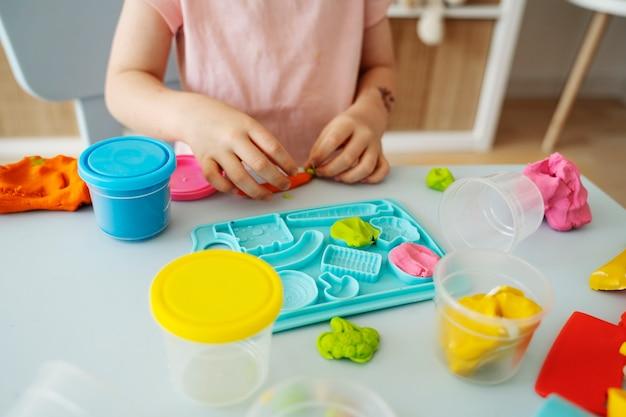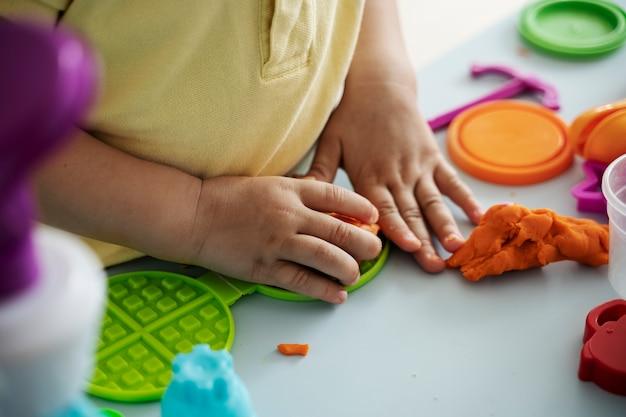Play dough is a timeless classic that has entertained children for generations. Its squishy texture and endless possibilities for creative play make it a favorite among kids and parents alike. But at what age should you introduce play dough to your little one? In this blog post, we will dive into the age-appropriateness of play dough and explore its benefits for young children. We’ll also answer common questions like whether homemade play dough should be refrigerated, if it’s safe for babies, and what to do with old play dough. So, grab a cup of coffee and let’s get started on this play dough journey!
What Age Is Play Dough Suitable For
If you’ve ever stumbled upon a colorful blob of squishy goodness called Play Dough, you know the irresistible urge to dive right in, regardless of your actual age. But let’s be real here – Play Dough has an age appropriateness that goes beyond the desire to smoosh and mold. So, what age is Play Dough suitable for? Let’s dive into the doughy depths and find out!
Babies: Tiny Hands and Taste Buds
While it may seem tempting to introduce Play Dough to your darling little baby, it’s essential to consider their safety and exploratory tendencies. Play Dough is not recommended for infants, as they have an uncanny ability to put everything in their mouths faster than you can say “cute little gum chewer.” Plus, their tiny hands might not yet possess the fine motor skills needed to enjoy the full wonders of dough manipulation.
Toddlers: The Picasso Wannabes
Ah, toddlers. They’re like walking abstract artists, aren’t they? With their wild imagination and uncontainable energy, it’s no surprise that Play Dough becomes a natural fit for these tiny Picassos-in-training. At around the age of 2, most toddlers will start to develop the coordination and curiosity necessary to dive into the squishy world of Play Dough. Just make sure to keep a watchful eye. We wouldn’t want their artwork migrating to the walls, now would we?
Preschoolers: Master Sculptors in Training
Preschoolers, those little marvels, are now fully equipped to unleash their inner sculptors. With their growing dexterity and creativity, Play Dough becomes an endless world of possibilities. Whether they want to mold a misshapen snowman or create an abstract modern art masterpiece, preschoolers aged 3 to 5 can delve into the sculpting goodness of Play Dough. Just be prepared for the occasional request to display their sculptures in a museum. No pressure.
School-Aged Kids: Architects of Doughy Dreams
Ready, set, sculpt! School-aged kids are at the pinnacle of their Play Dough prowess. With steady hands and budding imaginations, they can create intricate structures, miniature universes, and extraordinary creatures. As the age-old adage goes, Play Dough knows no limits for the 6 to 10-year-old maestros of molding. Just make sure to clear your schedule because these kids are about to embark on a doughy journey that could last for hours.
Tweens and Beyond: Therapy for the Kid Within
Who says grown-ups can’t indulge in a little Play Dough therapy? Whether you’re a tween, teen, or adult, there’s something undeniably nostalgic and stress-relieving about squishing and shaping that squishy wonderstuff. So, don’t shy away from Play Dough just because your age has ticked a few notches on the timeline. Embrace your inner child and let the sculpting therapy commence!
Play Dough transcends age, bringing joy and creativity to young and old alike. While it’s essential to consider safety and development when introducing Play Dough to children, there’s no denying the magic that can unfold when those colorful tubs come out to play. So, grab some dough, let your imagination run wild, and remember that no matter your age, Play Dough is there to mold your day into a masterpiece of squishy fun.
FAQ: What Age Is Play Dough Suitable For
Should homemade playdough be refrigerated
The good news is that homemade playdough doesn’t need to take up precious fridge space! Unlike store-bought playdough, which may spoil if left out, homemade playdough can be safely stored at room temperature in an airtight container. Plus, it’ll be ready for your little ones whenever creativity strikes!
At what age can toddlers do puzzles
Puzzles are a fantastic activity for toddlers to sharpen their problem-solving skills. Around the age of 2, toddlers can start exploring simple puzzles with chunky pieces. As they grow and develop, they can progress to more complex and challenging puzzles. So, get those tiny hands ready to conquer the puzzle kingdom!
What can you do with playdough for 2-year-olds
Playdough opens up a world of possibilities for imaginative play with 2-year-olds. They can squeeze, squish, and mold it into various shapes. Build a tiny house or a tower, create animals, or even a playdough pizza party! Let their creativity soar while enhancing their fine motor skills and hand-eye coordination.
Is playdough good for toddlers
Absolutely! Playdough is not only good, but it’s also great for toddlers! It’s an excellent sensory activity that stimulates their tactile senses and encourages exploration. Plus, playing with playdough helps develop their hand muscles, improves coordination, and nurtures their creativity. So, break out the colorful dough and let the fun begin!
What can you do with old playdough
Don’t throw away that tired-looking playdough just yet! There are plenty of ways to give it new life. Mix different colors together to create unique shades, add glitter or essential oils for extra sensory delight, or use cookie cutters and rolling pins to make fun shapes. With a little imagination, even old playdough can become a masterpiece!
Can you die from eating Playdough
While playdough is tempting to take a tiny nibble, especially for curious little ones, worry not! Commercially made playdough is non-toxic and safe to ingest in small amounts. However, it’s always best to discourage eating it as a regular snack. So, play, create, and have fun with playdough, but leave the taste-testing to other culinary adventures!
How do you introduce playdough to a toddler
Introducing playdough to your toddler is as easy as 1-2-3! Start by setting up a designated playdough area with a mat or tablecloth to contain the mess. Show your child how to roll, squish, and shape the dough, and join in on the fun! Encourage their creativity, provide cookie cutters or toy tools, and watch their imaginations come to life!
Can babies eat playdough
While playdough is a fun and engaging sensory activity for babies, it’s essential to keep them from nibbling on it. Babies explore the world through their mouths, so offering taste-safe alternatives like edible playdough made from baby-friendly ingredients can provide a safer sensory experience. Always supervise playtime to ensure their safety!
What is a good toy for a 2-year-old
When it comes to toys for 2-year-olds, it’s all about balancing fun and educational value. Building blocks, shape sorters, pretend playsets, and even simple musical instruments are fantastic choices. Don’t forget about our old friend, playdough! It offers endless entertainment and developmental benefits for those busy little hands and minds!
How do you make natural playdough
Natural playdough is a fantastic option if you prefer to avoid synthetic ingredients. Whip up a batch at home by combining 1 cup of flour, 1/2 cup of salt, 2 teaspoons of cream of tartar, 1 tablespoon of oil, and 1 cup of water. Stir well, cook over medium heat until it thickens, and voila! Add natural dyes or essential oils for a touch of sensory delight.
Can 2-year-olds do puzzles
Absolutely! 2-year-olds can embark on their puzzle-solving journey. However, choose puzzles specifically designed for their age group with large, sturdy pieces that are easy for their little hands to manipulate. Puzzle time with toddlers not only enhances their problem-solving skills but also boosts their hand-eye coordination and patience.
Can a 2-year-old play with playdough
Yes, indeed! Playdough is an incredible activity for 2-year-olds. It allows them to unleash their creativity, engage in sensory play, and develop fine motor skills. Just make sure to supervise playtime to ensure they don’t sample the playdough buffet. Encourage their imagination to run wild as they mold, squish, and shape their way to artistic brilliance!
What can toddlers learn from playdough
Playdough is a treasure trove of learning opportunities for toddlers. As they manipulate the dough, they strengthen their hand muscles, improve hand-eye coordination, and enhance fine motor skills. It also stimulates their imaginations, promotes problem-solving abilities, and encourages social interactions during collaborative play. Who knew a little ball of dough could do so much?
What happens if a dog eats playdough
Oh, that mischievous pup! If Fido manages to devour a bit of playdough, it might cause an upset tummy. However, if the playdough your dog ingests contains high levels of salt or other harmful additives, it’s crucial to contact your veterinarian right away. Remember, dogs have their own chew toys, and playdough is best reserved for their two-legged companions!
What was the first color of Play-Doh
Ah, the color that started it all! The original Play-Doh, introduced back in the glorious year of 1956, was a delightful off-white shade. Though it may seem less exciting compared to the vibrant colors we have today, that humble hue holds a special place in the hearts of Play-Doh enthusiasts worldwide. It’s a classic, just like a black and white movie!
What is the smell of Play-Doh
Ah, that unmistakable aroma! The iconic scent of Play-Doh has captured the hearts and noses of children (and adults) for decades. While the exact recipe for the scent remains a closely guarded secret, it’s often described as a blend of sweet, slightly vanilla-like notes with a hint of nostalgia. Ah, take a deep breath, and let the memories come flooding back!
Why is playdough bad for you
Hold on, not so fast! Playdough itself isn’t inherently bad for you. However, store-bought playdough may contain preservatives and artificial dyes that some individuals might want to avoid. Additionally, playdough should not be ingested as a regular snack due to its high salt content. As long as playdough is used as intended and not devoured like a three-course meal, it’s perfectly safe and loads of fun!
Why do we put salt in playdough
Salt gives playdough that perfect texture and consistency we adore. Besides its magical molding abilities, salt also acts as a preservative, allowing playdough to be stored and enjoyed for longer periods. So, next time you’re channeling your inner scientist or sculptor, remember to thank salt for its marvelous contribution to the delightful world of playdough!
Is homemade playdough safe
Absolutely! Homemade playdough is a fantastic alternative to store-bought options. By making it at home, you have control over the ingredients, ensuring a safer and more natural experience for your little ones. Just remember to stick to non-toxic ingredients and avoid any potential allergens or irritants. With homemade playdough, you can have peace of mind and a whole lot of fun!

